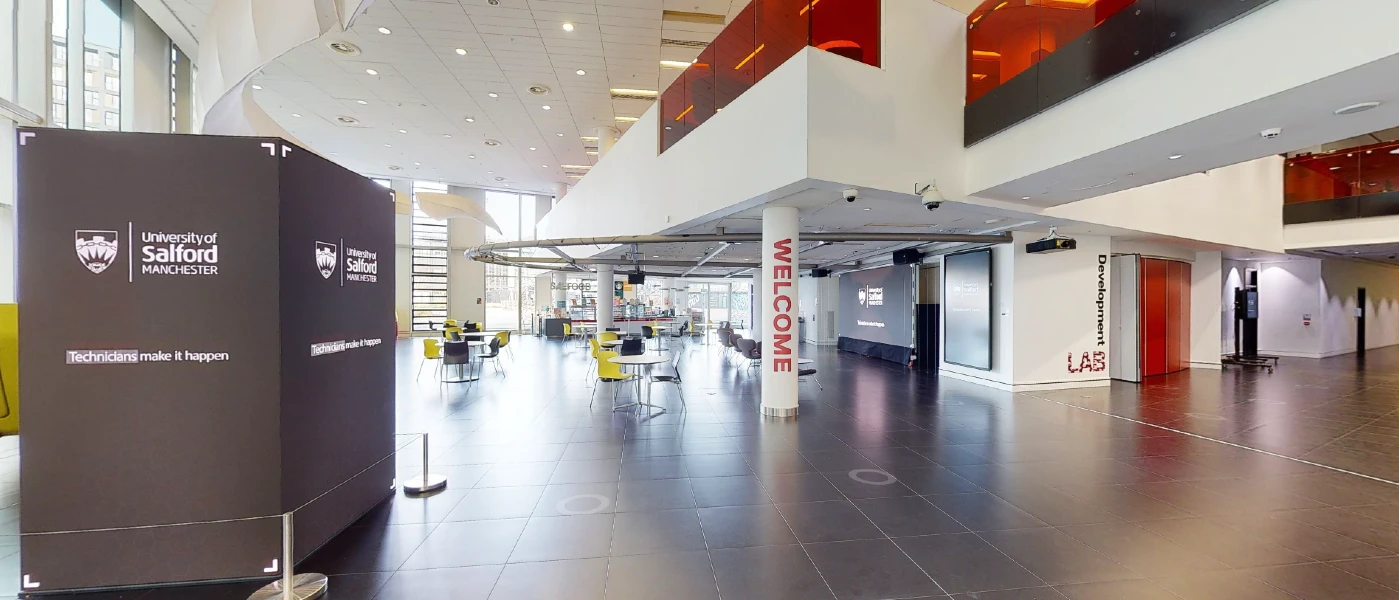The University of Salford’s MediaCity campus is now available to visit as a 3D virtual environment thanks to a new partnership with software company PixelMax
Through game engine technology, the campus’ ground floor has been digitally transformed into a fully interactive Metaverse space in which students and lecturers can interact and create new virtual spaces for teaching or displaying their work.
The space, which is now available for anyone to experience, was developed by a partnership between the University’s Creative Technical Services team and software company PixelMax who built the Metaverse that users inhabit using Unreal Engine from Epic Games.
With students and lecturers now inhabiting the space, the partnership is working with University programmes to design new virtual spaces for teaching purposes or incorporate virtual teaching elements into current modules.
Roger McKinley, Creative Technology and Content Manager of Creative Technical Services at the University of Salford said:
“This virtual environment is as close as you can get to a digital twin of the ground floor of our MediaCity campus.
“It’s fully inhabitable for anyone to see and experience. You just create your avatar and your use keyboard and keys to move around in it as you would in any video game. Students can talk to each other and their tutors in it as well as put their work on display.
“It’s a flexible, digital space for any course looking to create, use and preserve assets that bridge digital and physical spaces, from architecture to fashion, archaeology to engineering and many others. We’re only really limited by our own imagination.”
Proposals under discussion for the space include enabling Film Production students to build their own sets in the campus’ TV studios virtually and test the lighting of their sets before then building them in person and Fine Art students will being able to build galleries to exhibit their work through interactive portals within the space.
There have also been discussions with creative audio programmes about using the space to upload soundscapes that are attached to virtual objects, which would radically alter how these spaces both look and feel.
Louise Ready-Syrat, Programme Leader for BA Television and Radio Production said:
“The Digital Twin project will be a huge resource for the programme and wider directorate of film, broadcast media and creative technology. It is something that could showcase our students’ work and talents in a number of different ways making it more inclusive and accessible to all.”
For potential or new students, the virtual blueprint can also be of interest to those wanting to get a feel of the campus before arriving or for virtual open days when attendees may be unable to visit it in person.
It was initially created after Liverpool-based CaptureVR scanned the whole of the building in photogrammetry to produce a model of all three floors that was then picked up by the Creative Technical Services team and PixelMax to build out a Metaverse model using Unreal that is then hosted by PixelMax.
Joe Spencer, Head of Design at PixelMax said:
“When we were designing the space, our focus was on bringing to a life a digital version of the physical building and then integrating really exciting new tools, such as allowing users to dynamically change the lighting in the TV studios. It was about adding things to what you would get from the physical environment and then exploiting what we can then use within the digital environment.
“The product is marriage of industry expertise and academic innovation. We’ve a shared appetite to produce new products but also innovate in an academic sense. The opportunities for innovation are hugely exciting.”
The existing accessible space is regarded as just the blueprint with further exploration and innovation required to test new ways it can enrich the student experience and enable academics to test new ways of teaching.



